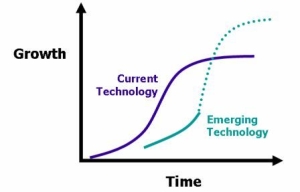
Atlanta, GA—a rapidly growing metropolitan area.
In today’s society, change can be seen everywhere. Cities are growing larger and larger, while new industries are springing up in all sectors. Over time, our economy has shifted from an agricultural base to a manufacturing base to a more service-based economy that relies on knowledge, technology, and innovation. This massive change can be attributed to economic development.
Economic development is the necessary and beneficial tool that allows communities and states to flourish in a fast-paced world. It is crucial for cities and states to be attractive to industries as well as individuals. In this two-part post, we will consider some avenues of promoting economic development, sometimes in unexpected and surprising ways. Each of these methods has the potential to create a significant economic impact in the areas where they are utilized effectively.
Education

The Innovation Life Cycle.
An educated population has the potential to provide countless benefits to a community. Individuals with higher education typically have a larger salary and work in the best positions in some of the nation’s top industries. Many industries and companies are becoming obsolete, and innovative thinkers in an educated population will be the ones that can provide a solution that fills in the gaps with new industry. The graphic to the right visually represents the need for fresh, new ideas. The link between education and economic development, while slightly indirect, is necessary for economic growth.
An econometric study by Aghion et al. (2009) found positive economic growth effects from investments in four-year college education in the United States, but not from investment in two-year college education. The researchers also found that investments in research universities have positive growth effects only in states fairly close to the technological frontier, where more innovation is likely to occur. Investments in both four-year college education and research universities increased patenting of inventions.
In Europe as well, a study by the European Commission Joint Research Centre (Villaba 2007) found a moderate association between higher levels in several educational benchmark indicators and increased innovation. Participation in lifelong learning; graduates in math, science, and technology; and high literacy levels were positively correlated with innovation. Higher levels of the educational benchmark indicators were also highly correlated with more innovation-friendly markets, which may indicate that a better-educated population is better prepared to receive innovation.
Availability, Affordability, and Attractiveness of Housing
One of the primary goals of economic development is to create jobs. However, these new employees should be able to find a safe and appealing place to live. For economic development to be effective, there must be an adequate amount of housing that appears attractive to potential residents. Here is a recent example: the hydraulic fracturing, or fracking, industry has shown the difficulties that arise when economic development and job growth are not paired with enough housing. While fracking created many new jobs in various areas throughout the country in recent years, many of these areas lacked sufficient housing for the workers. Many fracking site workers ended up living in their vehicles, tents, or barrack-style housing. The limited housing that was available near these sites was incredibly expensive—sometimes even pricier than rents in the New York City and Washington, D.C. metropolitan areas, where the housing stock is also limited. Enough housing is critical for effective, sustainable economic growth.

The San Francisco Bay Area has been challenged to provide sufficient affordable housing to meet demand. San Francisco houses courtesy of Wikimedia Commons user King of Hearts, CC BY-SA 3.0.
According to Big Sky Economic Development, quality housing that is affordable and available is essential to attracting workers to a community. High-quality housing adds value to the community and attracts residents to the area, creating the strong workforce necessary for the effectiveness of economic development. The development that occurs in locations with a sound real estate market can flourish for generations as families choose attractive cities to call home.
Government Programs and Incentives
State and local governments often offer incentives that lead to economic growth and development. For example, Business USA states that revolving loan funds provide businesses and entrepreneurs with gap financing needed to start or expand their business. These loans characteristically have lower interest rates and are tied directly to job creation and retention, resulting in economic development.
Business improvement districts, or BIDs, also provide a boost to local economies. A BID is a defined area where business owners are required to pay an additional tax which is used to fund projects and improvements within the district. Tourism and sales tax revenue is often increased through BID events and projects. A BID also improves the aesthetic appeal of the area within its boundaries. Tourism and community events certainly lead to increased economic growth in municipalities.
Brownfield redevelopment incentives are also a major way that governments can stimulate economic development while adding to the attractiveness of an area. Brownfield property, or abandoned or underutilized land that is contaminated or feared to be contaminated, provides an outlet for future economic growth. These government incentives often offer grant funds in exchange for remediating and converting contaminated sites into areas where communities can thrive. These areas can be used to develop commercial retail establishments that increase tax revenue as well as parks which enhance the vibrancy of the community. To learn more about brownfield redevelopment, you might start with our blog post from a few months ago.
Looking Ahead
I will expand this list of unexpected approaches for economic development in part two of this series. Have you noticed economic growth being promoted in a unique way in your area? Let us know in the comments below.





Recent Comments